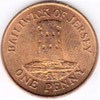
The construction of Le Hocq Tower was started in 1781 a few months after the "Battle of Jersey" (On 6 January 1781 there was an attempt by French forces to invade Jersey and remove the threat the island posed to French and American shipping in the American War of Independence. Jersey was used as a base for privateering by the British and France, engaged in the war as an ally of the United States, sent an expedition to gain control of the island. The expedition ultimately failed, and its commander, Baron Phillipe de Rullecourt, died of wounds sustained in the fighting as did the English commander Major Pierson who was leading the 2.000 troops of the British garrison.)
Although frequently called a "Martello tower", these round towers or Conway's towers are taller, and they predate the development of true Martello towers. The round towers differ from Martello towers in several ways. The Jersey towers are mostly built with local granite rather than brick and have a slighter "batter" (taper), The ground floor was used to store ammunition and weapons whilst the upper floor housed up to ten troops and their commanding officer. Le Hocq tower is painted partly in white on the seaward side to serve as a "daymark" (navigational aid).

The livre was the currency of Jersey until 1834. It consisted of French coins which, in the early 19th century, were exchangeable for sterling at a rate of 26 livres = 1 pound. After the livre was replaced by the franc in France in 1795, the supply of coins in Jersey dwindled leading to difficulties in trade and payment. In 1834, an Order in Council adopted the pound sterling as Jersey's sole official legal tender, although French copper coins continued to circulate alongside British silver coins, with 26 sous equal to the shilling. Because the sous remained the chief small-change coins, when a new copper coinage was issued for Jersey in 1841, it was based on a penny worth 1⁄13 of a shilling, the equivalent of 2 sous. This system continued until 1877, when a penny of 1⁄12 of a shilling was introduced. Along with the rest of the British Isles, Jersey decimalised in 1971 and began issuing a full series of circulating coins from ½p to 50p. £1 and £2 denominations followed later. The reverse side of the 1p coin depicts Le Hocq tower.

The latest Jersey pound note design (2010) has a picture of Le Hocq tower. On 26 April 2010 a new set of Jersey banknotes was issued. The notes are trilingual, containing text in English, French and Jèrriais. On June 1, 2012, a £100 note was issued to commemorate the Diamond Jubilee of Queen Elizabeth II. The obverse of the notes (£1-£50) includes a portrait of Queen Elizabeth II based on a photograph by Mark Lawrence, alongside a view of an important Jersey landmark, with text in English. On these notes the Queen is wearing the Vladimir Tiara as opposed to a crown in recognition of her title in Jersey; Duke of Normandy. The reverse of each note includes an image of one of Jersey's numerous historic coastal defence towers, built in the late 18th century, as well as a further image of cultural or landscape importance, images of the twelve parish crests, and with denomination worded in French and Jèrriais. The Jersey cow watermark is retained, and further security features include a see-through map of Jersey. A short clip about the history of the Jersey currency can be found on the Sates of Jersey official website http://www.gov.je/TaxesMoney/JerseyCurrency/Pages/JerseyCurrencyNew.aspx
Alongside the tower is the Millennium Cross of St. Clement, one of twelve granite wayside crosses erected to mark the millennium in 2000-2001.
[FR] Sur la route de bus no. 1 (l'arret "Le Hocq") N'oubliez surtout pas de chercher dans votre monnaie la pièce de 1 pence sur laquelle figure la Tour du Hocq - si vous voulez rapporter un souvenir de plus grande valeur, une image de la tour figure aussi sur le billet de banque d'une livre.